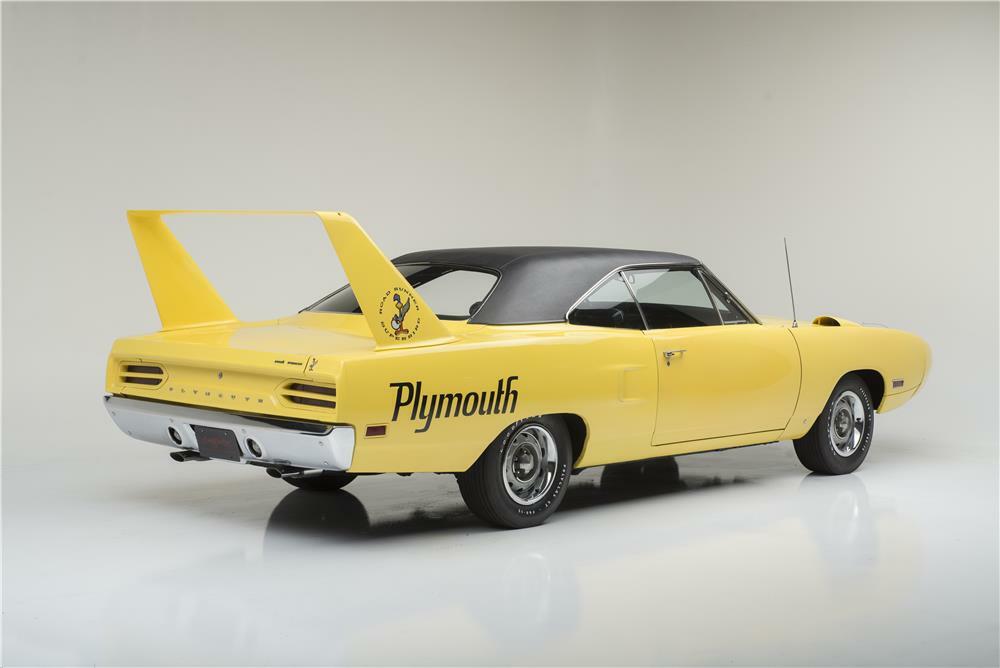1970 Plymouth Superbird

The descriptions of the Classic Cars in the Directory were partly generated or supplemented with the help of artificial intelligence (AI). The content may occasionally not always be entirely accurate or factually correct despite careful checking.
The 1970 Plymouth Superbird is a high-performance car that was produced by Plymouth as a limited-edition version of the popular Road Runner. It was designed as a homologation model for use in the NASCAR Grand National series and was built in limited numbers, making it one of the most sought-after muscle cars of all time.
At the heart of the Superbird is a powerful 440 cubic inch, V8 engine that is capable of producing up to 375 horsepower and 480 lb-ft of torque. This engine was mated to a four-speed manual transmission or an optional three-speed TorqueFlite automatic, which allowed the Superbird to reach a top speed of 150 mph.
One of the most distinctive features of the Superbird was its aerodynamic design. The car featured a long, pointed nose cone that extended the length of the car by nearly two feet, as well as a massive rear wing that was almost four feet tall. These design elements were added to improve the car's stability and traction at high speeds and made it instantly recognizable on the racetrack and the street.
The Superbird also featured heavy-duty suspension and brakes to handle the car's immense power and speed. Upgraded front disc brakes were standard, and the car's suspension was designed for optimal handling and cornering capability. The car featured a fast-ratio power steering system, as well as an optional limited-slip differential to improve traction and handling.
Inside the Superbird, the car was equipped with all the standard features of the Road Runner, including bucket seats, a floor console, and a pistol grip shifter. However, the Superbird also came with added features such as a tachometer, a rallye instrument cluster, and a leather-wrapped steering wheel.
Overall, the 1970 Plymouth Superbird is an iconic muscle car that is known for its powerful engine, aerodynamic design, and excellent handling. It remains a highly sought-after collector's car and is considered by many to be one of the greatest muscle cars of all time.
Milestones
- 1970: Plymouth Superbird is introduced as a limited-edition model. - The car is based on the Plymouth Road Runner and features an aerodynamic nose and high rear wing. - The Superbird is equipped with a 426 cubic-inch Hemi V8 engine that produces 425 horsepower. - A total of 1,935 Superbirds are produced for homologation purposes. - The Superbird is designed to compete in NASCAR, and Richard Petty drives one to victory at the Daytona 500 in 1970. - Due to changes in NASCAR rules, the Superbird's racing career is short-lived, and production is discontinued at the end of the year. - The Superbird remains a highly sought-after collectible car, with rare and well-preserved examples fetching high prices at auction.Technical
- Engine: 7.0-liter (426 cubic-inch) Hemi V8 engine - Horsepower: 425 horsepower - Torque: 490 lb-ft - Top speed: 150 mph - Transmission: Four-speed manual or three-speed automatic - Rear axle ratio: 4.10:1 - Suspension: Revised front and rear suspension for enhanced stability and handling - Brakes: Power-assisted front disc brakes and rear drum brakes - Tires: 15-inch chrome-plated wheels with F70x14 tires - Body style: Two-door hardtop with a rear spoiler and extended nose cone - Dimensions: Length: 229.7 inches, Width: 76.4 inches, Height: 53.2 inches, Wheelbase: 115 inches - Weight: 3,800 lb (approx.) - Production numbers: Only 1,920 Superbirds were produced by Plymouth in 1970.